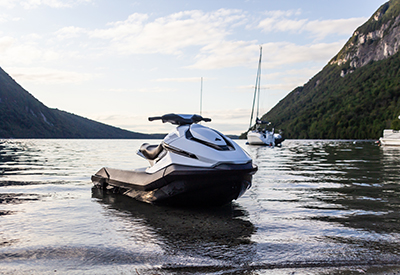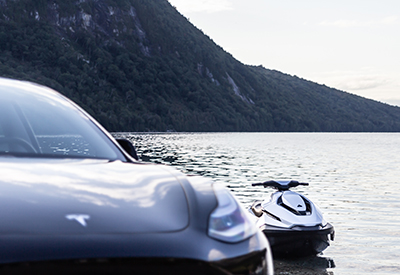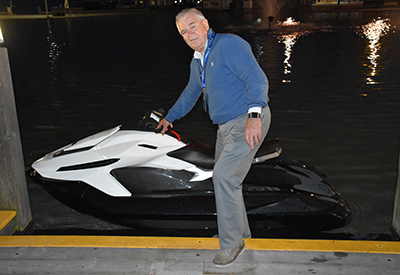Electric PWC previewed in Toronto

Sept 26, 2019
Taiga Motors, the Canadian company behind the world’s first electric snowmobiles, rolled out their first electric personal watercraft, Orca on Toronto’s Harbourfront on September 17. It’s in the mood of Tesla with a carbon fibre hull – a classy execution with an initial special edition price tag of US$28K to match!
Taiga’s electric drive platform translates seamlessly to a jet propulsion system. At under 600lbs ready to drive and up to 180 horsepower available with instant torque, the craft offers leading power to weight and agility for an unmatched ride experience.
Dynamic design: Form follows function
Orca was designed from a clean sheet to embody the elegant, powerful, and playful characteristics of its namesake. Without the restrictions imposed by combustion engines, the designers were free to rethink traditional design practices that have constrained personal watercraft design over the past decades.
The new suspended seat design highlights the reduced packaging height of the electric drive, allowing for the lowest center of gravity of any personal watercraft. For the rider this translates to enhanced stability and precision carving on the water. Adjustable sponsons allow users to easily adjust the ride dynamics from leisurely play to racing characteristics.
At 2.90 meters (9.5 ft) long, 1.2meters (3.9 ft) wide and 1.01 meters (3 ft) tall, the design breaks away from the tradition of building bigger and more powerful personal watercrafts. With up to 180 horsepower and under 600lbs ready to drive, the Orca delivers one of the highest power to weight ratios in the industry while remaining nimble, silent, and practical for every day use on the water.
Video link
Powerful efficiency: The electric drive
 Taiga’s electric drive platform is at the heart of the shift towards a new era of powersports without compromise.
Taiga’s electric drive platform is at the heart of the shift towards a new era of powersports without compromise.
The performance package equipped Orca can generate over 134kW (180hp) for incredible acceleration and a top speed up to 104km/h (65mph). With a sub 5-milisecond response time, the drive delivers incredible control on any terrain. Precision impeller speed control is achieved to maximize efficiency and reduce noise levels under varying conditions. Unlike many electric vehicles, a high-power output can be sustained thanks to Taiga’s advanced thermal management system. The innovative closed loop cooling circuit running through the battery, motor, and inverter has been tested to maintain temperature regulation from arctic to tropical conditions.
Orca’s lithium-ion battery runs on an automotive standard system voltage of 400 volt. The 23kWh battery capacity provides energy for up to 2 hours under typical drive conditions. Weighing in at approximately 125kg, the Orca’s battery delivers one of the highest energy densities of any electric vehicle and the most specific power for any battery of its size. Orca can be charged from a regular outlet for convenient overnight charging, from standard automotive chargers at a rate of up to 10kW, or by DC fast charging to 80% in 20 minutes for high throughput operators.
 CY’s Greg Nicoll up close and personal with Orca
CY’s Greg Nicoll up close and personal with Orca
Environment
The heated debate over personal watercraft use in bodies of water shared by homeowners, marine life, and other recreational watersport enthusiasts has been active since the late 90s. At the heart of the controversy is pollution and noise levels. Although manufacturers have made the switch to cleaner 4- stroke engines, a modern personal watercraft produces up to 16 g/kWh of hydrocarbons (HC) and nitrogen oxide (NOx) and 300 g/kWh of carbon monoxide (CO). This is more than 80 times the EPA’s Tier 2 emission standards for automobiles. Their noise levels can exceed 90 dBA at distance of up to 100 feet, especially in wavy conditions when the jet impeller breaches the waters surface. Orca presents a solution to bridge the societal rift between those ultimately looking to enjoy a day by the water, producing 0 g/kWh of emissions and a quiet ride.
Following Orca, Taiga will be entering the recreational personal watercraft segment with models priced below $14,000 USD and expanding their electric propulsion platform to bring electric inboard and outboard products to the boating industry at large.





























